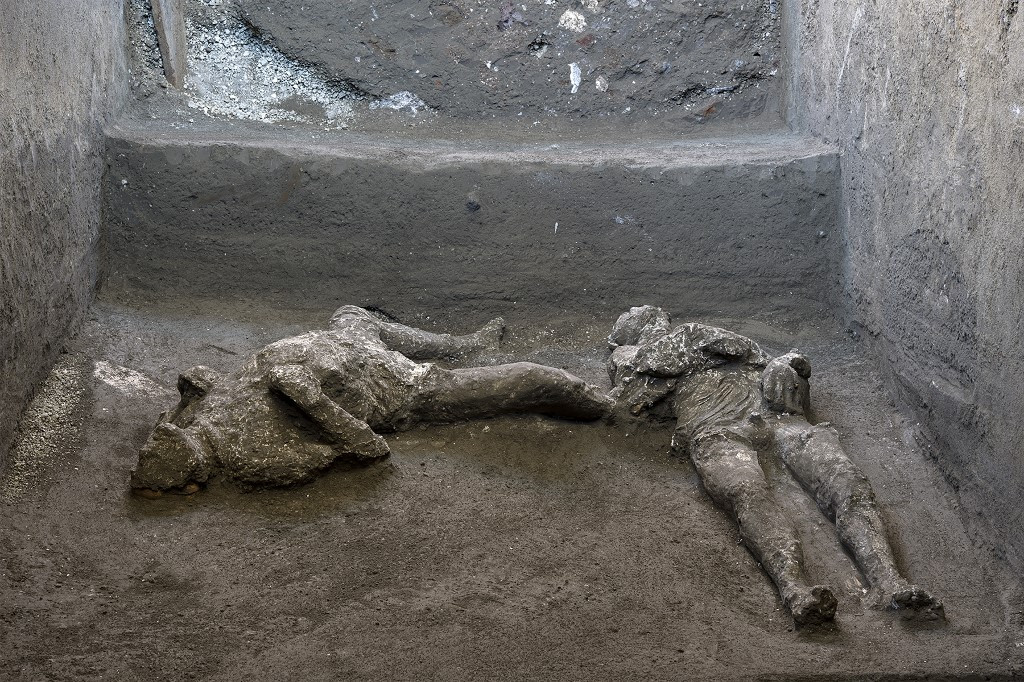Popular Reads
Top Results
Can't find what you're looking for?
View all search resultsPopular Reads
Top Results
Can't find what you're looking for?
View all search resultsRemains of two victims of 79 AD volcanic eruption unearthed at Pompeii
The researchers believe the figures are those of a young slave and a richer older man, around 40 and presumed to be his owner, based on the vestiges of clothing and their physical appearance.
Change text size
Gift Premium Articles
to Anyone
 This undated photo handout on November 21, 2020 by the Pompeii Archaeological Park shows casts of the bodies of two men, a 40-year-old master and his young slave, after they were found during recent excavations of a Villa in Civita Giuliana in the outskirts of Pompeii, as Park officials said conditions were optimal to get casts of the victims, following the technique perfected in 1863 by Giuseppe Fiorelli. The ancient Roman city of Pompeii was engulfed under a hail of volcanic ash after nearby Mount Vesuvius erupted in the year 79. Vesuvius' eruption covered the in a toxic, metres-thick layer of volcanic ash, gases and lava flow which then turned to stone, encasing the city, allowing an extraordinary degree of frozen-in-time preservation both of city structures and of residents unable to flee.
(Agence France Presse/Handout / POMPEI ARCHAEOLOGICAL PARK /)
This undated photo handout on November 21, 2020 by the Pompeii Archaeological Park shows casts of the bodies of two men, a 40-year-old master and his young slave, after they were found during recent excavations of a Villa in Civita Giuliana in the outskirts of Pompeii, as Park officials said conditions were optimal to get casts of the victims, following the technique perfected in 1863 by Giuseppe Fiorelli. The ancient Roman city of Pompeii was engulfed under a hail of volcanic ash after nearby Mount Vesuvius erupted in the year 79. Vesuvius' eruption covered the in a toxic, metres-thick layer of volcanic ash, gases and lava flow which then turned to stone, encasing the city, allowing an extraordinary degree of frozen-in-time preservation both of city structures and of residents unable to flee.
(Agence France Presse/Handout / POMPEI ARCHAEOLOGICAL PARK /)
T
he remains of two victims of the eruption of Mount Vesuvius almost 2,000 years ago have been unearthed at a grand villa on the fringes of Pompeii, officials at the archaeological site said Saturday.
"Two skeletons of individuals caught in the fury of the eruption have been found," the officials at the Italian site near Naples said in a statement.
The researchers believe the figures are those of a young slave and a richer older man, around 40 and presumed to be his owner, based on the vestiges of clothing and their physical appearance.
The ruined city of Pompeii was submerged in ash after the eruption of Mount Vesuvius in 79 AD. It is now Italy's second-most visited tourist attraction after Rome's Colosseum, receiving nearly 4 million visits last year.
The massive site that spreads over 44-hectares (110-acres) is what remains of one of one the richest cities in the Roman empire. Layers of ash buried many buildings and objects in a nearly pristine state, including curled-up corpses of victims.
After the latest human remains were uncovered, the bones were analysed and then plaster was poured in, a technique invented by Giuseppe Fiorelli in 1867.
This creates a plaster cast which shows the shapes of the bodies of the two victims, in a supine position, where they fell.
The two skeletons were found, during ongoing excavations at Civita Giuliana, around 700 metres northwest of Pompeii, at a villa overlooking the Bay of Naples where previously a stable and the remains of three harnessed horses had been found.
The two bodies were found in a side room of the "cryptoporticus" a corridor below the villa where the could have gone to seek shelter.
While excavations continue at the Pompeii site, tourism has stopped due to coronavirus measures.









